Krapina Špilja
Hušnjakovo
Useful Information
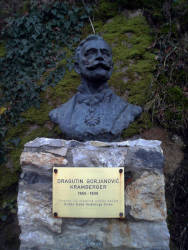
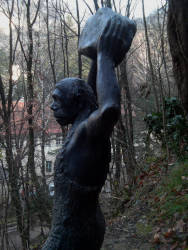
| Location: |
Šetalište Vilibalda Sluge bb, 49,000 Krapina.
50 km from Zagreb in Krapina. A1 E59 Maribor-Zagreb exit 3 Krapina or exit 2 Durmanec, 1 to Krapina. Museum/Hušnjakovo signposted. (46.1654269, 15.8632177) |
| Open: |
NOV to FEB Tue-Sun 9-17, last entry 16. MAR Tue-Sun 9-18, last entry 17. APR to SEP Tue-Sun 9-19, last entry 18. OCT Tue-Sun 9-18, last entry 17. Closed 01-JAN, Easter, 01-NOV, 24-DEC, 25-DEC, 26-DEC, 31-DEC. [2024] |
| Fee: |
Adults EUR 10, Children EUR 5, Children (0-3) free, Students EUR 5, Seniors EUR 5, Family (2+*) EUR 20.50, Audioguide EUR 2. Groups (30+): Adults EUR 9, Children EUR 4.50, Children (0-3) free, Students EUR 4.50, Seniors EUR 4.50. [2024] |
| Classification: |
 Erosional Cave Erosional Cave
 Sandstone Cave Sandstone Cave
|
| Light: | n/a |
| Dimension: | A=160 m asl. |
| Guided tours: |
self guided.
Audioguide D=70 min.








|
| Photography: | allowed |
| Accessibility: | yes |
| Bibliography: |
Jim Ahern (1999):
New perspectives on the Krapina frontal sample and supraorbital change in late Pleistocene south-central Europe.
Presented at Krapina: 1899-1999, Zagreb, Croatia.
David W. Frayer, Jorg Orschiedt, Jill Cook, Mary Doria Russel, Jakov Radovčić (2006): Krapina 3: Cut Marks and Ritual Behavior? Periodicum Biologorum. 108 (4): 523–524. Retrieved 18 January 2021. pdf Herbert Ullrich (2005): Cannibalistic Rites Within Mortuary Practices From The Paleolithic To Middle Ages In Europe, Anthropologie (1962-) Vol. 43, No. 2/3 (2005), pp. 249-261 (13 pages), Moravian Museum. online pdf jstor |
| Address: |
Muzej Krapinskih Neandertalaca, Šetalište Vilibalda Sluge bb, 49,000 Krapina, Tel: +385-49-371-491.
E-mail: Reservations: Tel: +385 49 371 491, Fax: +385 49 374 968. E-mail: |
| As far as we know this information was accurate when it was published (see years in brackets), but may have changed since then. Please check rates and details directly with the companies in question if you need more recent info. |
|
History
| 23-AUG-1899 | palaeontologist Dragutin Gorjanović-Kramberger visits the cave the first time. |
| 1899-1905 | excavated and two monographs published by Dragutin Gorjanović-Kramberger. |
| 1961 | declared the first paleontological Natural Monument in the Republic of Croatia. |
| 1999 | Alan Mann and Janet Monge discovered signs of a bone tumour in one of the Neanderthals bones. |
Description
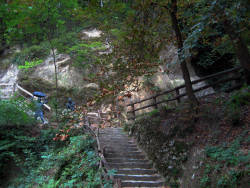
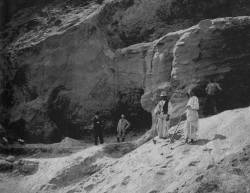
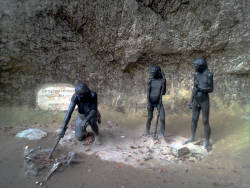
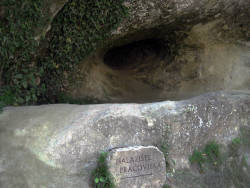
Krapina Špilja (Krapina Cave) is of extraordinary importance for archaeology. In this cave the Croatian paleoanthropologist Dragutin Gorjanovic-Kramberger discovered numerous bones of Neanderthals. The bones at Krapina were dated to be 100,000 years old, and the type of hominide found here is called Homo krapiniensis after the cave. A collection of artifacts and bones can be seen at the Museum of Early Man in Krapina.
Gorjanovic-Kramberger visited the cave first on 23-AUG-1899, after he was alerted by a local schoolteacher. He soon found chipped stone tools, some animal bones and a single human molar. This convinced him to make further excavations, and so he and his colleagues found a huge collection of fossilized remains of early hominids during the next six years. These hominids belonged to the Neanderthals (Homo sapiens neanderthalensis), named after the Neanderthal valley in Germany where the first bone ever was found. Neanderthals were very similar to humans and have the same predecessors, but due to difference in physiognomy they were thought to be a separate species. The newest genetic research tells us that they are not a separate spezies, as it was obviously possible to interbreed. Neanderthals became extinct about 30,000 years ago, but modern humans have a few percent Neanderthal genes.
Krapina cave is among the most valuable Neanderthal locations in the world. The bones became famous, not only because of the number, quality and age of the bones. About nine hundred human fossil bones represent the largest and richest collection of Neanderthal remains collected in one locality. They belong to dozens of individuals of different sexes and aged from 2 to 27 years. Also, the remains of cave bear, gray wolf, elk, giant deer, warm-season rhinoceros, wild boar and many other animals were excavated.
Traces on the bones were interpreted as remains of cannibalism. However, most cannibalism theories later proved to be just the wishful thinking of archaeologists, which have read to many adventure stories. They were based on two facts, broken bones (to eat the marrow) and shattered skulls. Both are easily explained with pressure in the cave sediment or secondary burials, where the bodies were the remains of a burial which was later relocated into the cave. Whether Krapina Neanderthals engaged in cannibalism remains open, but is quite far from being likely.
Recent research on the health of the Neanderthals was rather astonishing, as they revealed an extraordinary good health, which was not expected. Alan Mann and Janet Monge, two American researchers, studied X-rays of 884 bones. The few exceptions were a bone tumour, osteoarthritis, and a hand which was surgically amputated. The latter would even suggest some medical knowledge, which definitely challenges the cliché of a stupid cave man.
We have listed the site as a show cave, as it is a cave and open to the public, but actually it is not a show cave at all. Originally there was an erosional cave in sandstone, a ledge with overhanging cliff which was used as a shelter. This is quite exceptional, as Croatia is more or less in its entirety covered by karstified limestone. The overhang crumbled away over the millennia and continuously covered the remains of the Neanderthals with sand and gravel. At the end, the cave was gone, and there was a deposit of more than 8 m of gravel full of bones and artifacts. The forested valley has a stream, the shelter is located on the northern side facing south, a nice and sunny place with drinking water nearby, ideal for spending some time. The locals called the place Hušnjakovo.
This is an archaeological excavation, and it is documented in a new museum, the Muzej krapinskih neandertalaca (Krapina Neanderthal Museum) or short Kraneamus. The museum was built in the valley, right below the cave, across the stream which flows underground through the museum. Except for the glass facade, the whole museum is covered by grass, so it actually looks like an underground museum. It contains a sort of cave replica showing the site how it looked before it was excavated. It also has numerous dioramas with very well done reconstructions of Neanderthals. There is a trail which starts at the parking, goes to the monument for Gorjanovic-Kramberger, to the museum, up the hill to the cave and then back to the parking lot. The cave contains a set of bronze statues, which are also an attempt to reconstruct living Neanderthals.
- See also
 Search DuckDuckGo for "Krapina Cave"
Search DuckDuckGo for "Krapina Cave" Google Earth Placemark
Google Earth Placemark Krapina Neanderthal site - Wikipedia (visited: 29-JAN-2024)
Krapina Neanderthal site - Wikipedia (visited: 29-JAN-2024) Kraneamus Muzej krapinskih neandertalaca, official website
Kraneamus Muzej krapinskih neandertalaca, official website  (visited: 29-JAN-2024)
(visited: 29-JAN-2024) "And Oh So Healthy." Archaeological Institute of America 1999 (visited: 29-JAN-2024)
"And Oh So Healthy." Archaeological Institute of America 1999 (visited: 29-JAN-2024) The Krapina Neanderthal Museum (visited: 29-JAN-2024)
The Krapina Neanderthal Museum (visited: 29-JAN-2024) Neanderthal Museum Krapina (visited: 29-JAN-2024)
Neanderthal Museum Krapina (visited: 29-JAN-2024) Krapina Neanderthal Site (Krapina, Croatia) (visited: 29-JAN-2024)
Krapina Neanderthal Site (Krapina, Croatia) (visited: 29-JAN-2024)
 Index
Index Topics
Topics Hierarchical
Hierarchical Countries
Countries Maps
Maps